Editor’s note: This article was originally published in Overland Journal’s 2021 Fall issue.
For vehicle-bound travelers, storing and utilizing power when you are away from the electrical grid can be a daunting task. Many travelers spend significant time learning the skills to design and install off-grid electrical systems in their rigs. But not everyone has the time or desire to take this approach. Lack of experience and knowledge can also lead to installations that neglect key safety elements. The safer and easier route of paying a qualified electrician is one option, but it comes at a substantial cost.
Thankfully, due to an increased demand for simple and accessible off-grid power solutions that produce AC and DC power, we have seen a rise in all-in-one products. Many of these solutions strike a desirable balance between cost and convenience. They also offer versatility and mobility that are unmatched by a hardwired system.
If you are one of the travelers that I alluded to above and you’re looking to bring some off-grid power along on your next adventure, this article is for you. I got my hands on five of the leading all-in-one off-grid battery boxes and tested them in the lab and field, and can offer some data and opinions to help you make an educated decision about which one is right for you. It should be noted that these products all have slightly different capacities, and therefore, despite my best efforts, this is not a perfect case of comparing apples to apples.
TESTING PROCEDURES

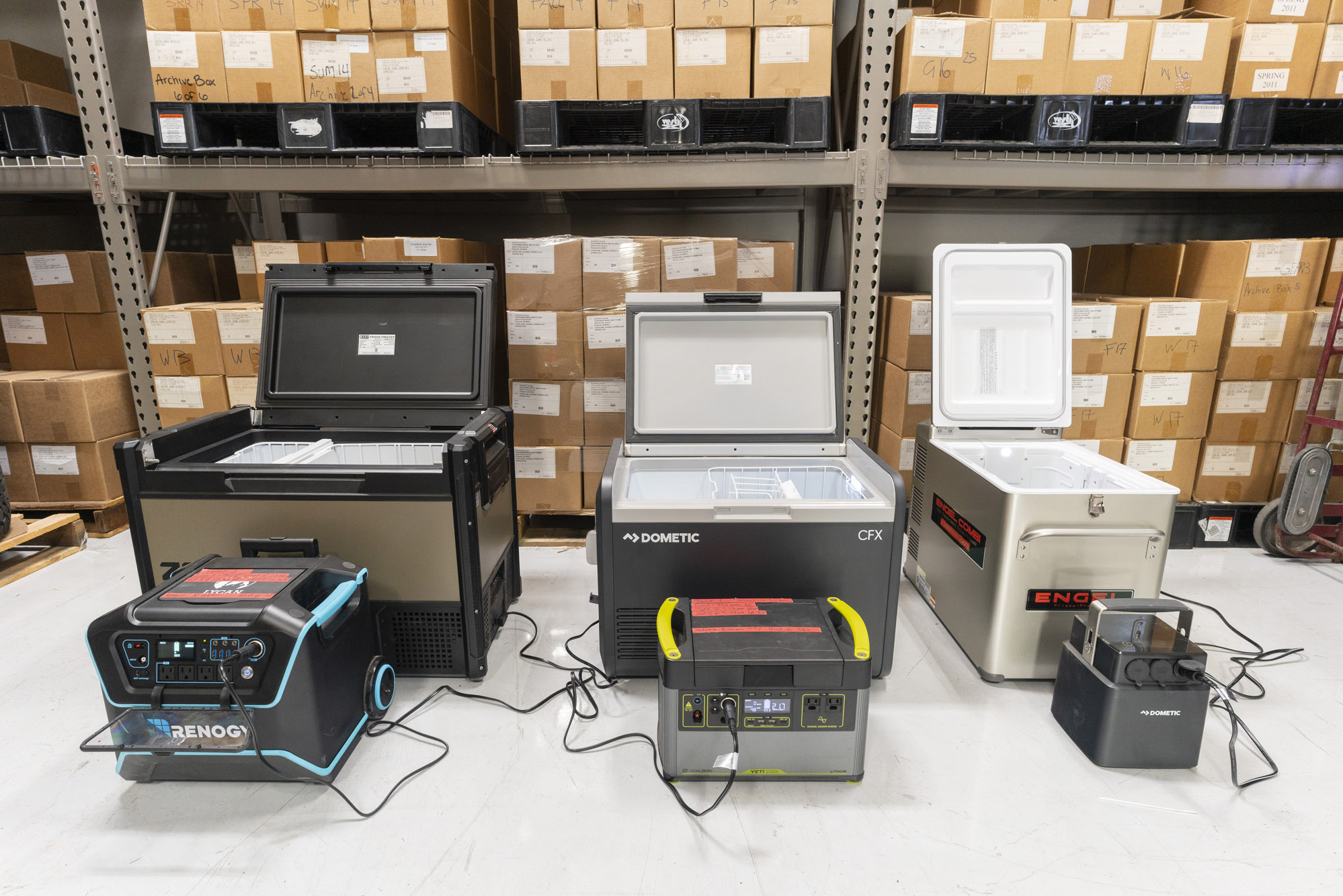
These products were put to use in real-world situations as well as in a lab setting. While my tests in the field helped develop subjective opinions about overall product design and function, multiple days of laboratory—to be more accurate, Overland International HQ garage bay—testing helped back up my findings with some hard data.
I put each of these products through two tests designed to get some hard and fast numbers.
1,000-WATT AC LOAD TEST A 1,000-watt alternating current (AC) load in the form of a halogen shop light was applied to each battery box (with the exception of the Dometic PLB-40). Each battery box was started at a 100-percent charge, and I timed how long it took for the AC load to drain the battery to 20 percent (the recommended discharge for optimal battery life).
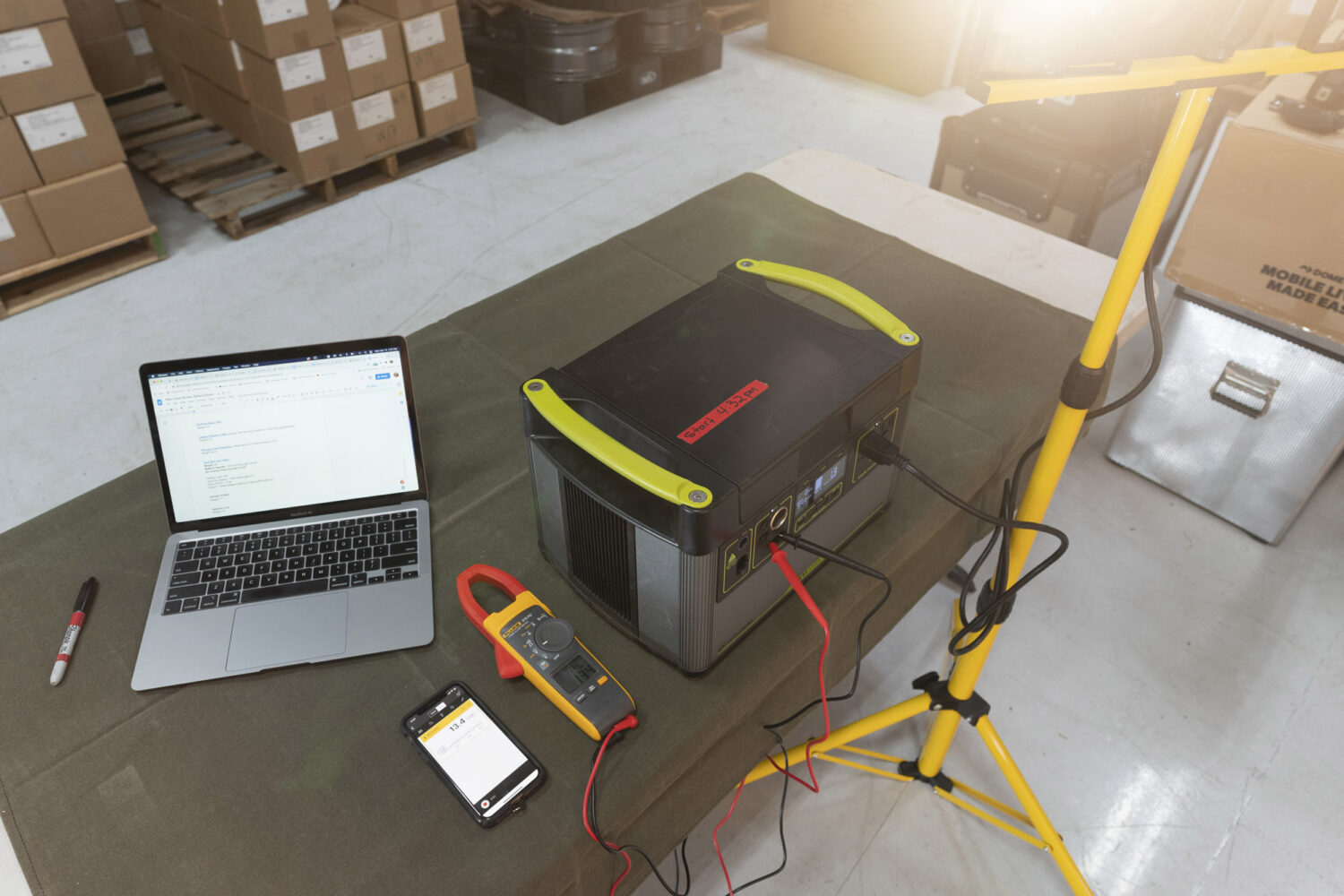
AC CHARGING TEST Utilizing the standard AC charging adaptors included with the battery boxes, I timed how long they each took to charge from 20-percent capacity to 100-percent capacity.
POTENTIAL FLAWS IN TESTING PROCEDURES AND BIASES
The extent of my training as a laboratory scientist ends at the high-school level, and I do not have any formal training in electrical engineering. I did, however, via YouTube and various blogs, learn how to install a stand-alone solar power system in my 1964 RV. During the extent of my ownership of that vehicle, no fuses burned up, and no electrical fires ever occurred.
Both of my tests for this gear review were fairly simple. However, there is the potential that I miscalculated times or transcribed numbers since I was recording everything manually.

Without access to internal components, I was unable to validate any of the values displayed on product screens except the AC and DC output wattage/voltages. I am happy to report that those numbers all fell within a reasonable range of what was advertised by each product and were verified with a Fluke voltage meter. I was also pleasantly surprised to find that DC output was regulated on all of the products that I tested, resulting in consistent DC voltage output all the way down to our benchmark of 80-percent battery discharge.
Beyond these technical observations and insights, there are my own biases that should be taken into consideration. For instance, I have owned the Jackery Explorer 1000 for the better part of the last year, so I was already familiar with it. There is also the impact of product marketing. Even the color and shape of our test products inevitably made an impression, no matter how much I attempted to look past the minutiae.
GOAL ZERO | YETI 1500X
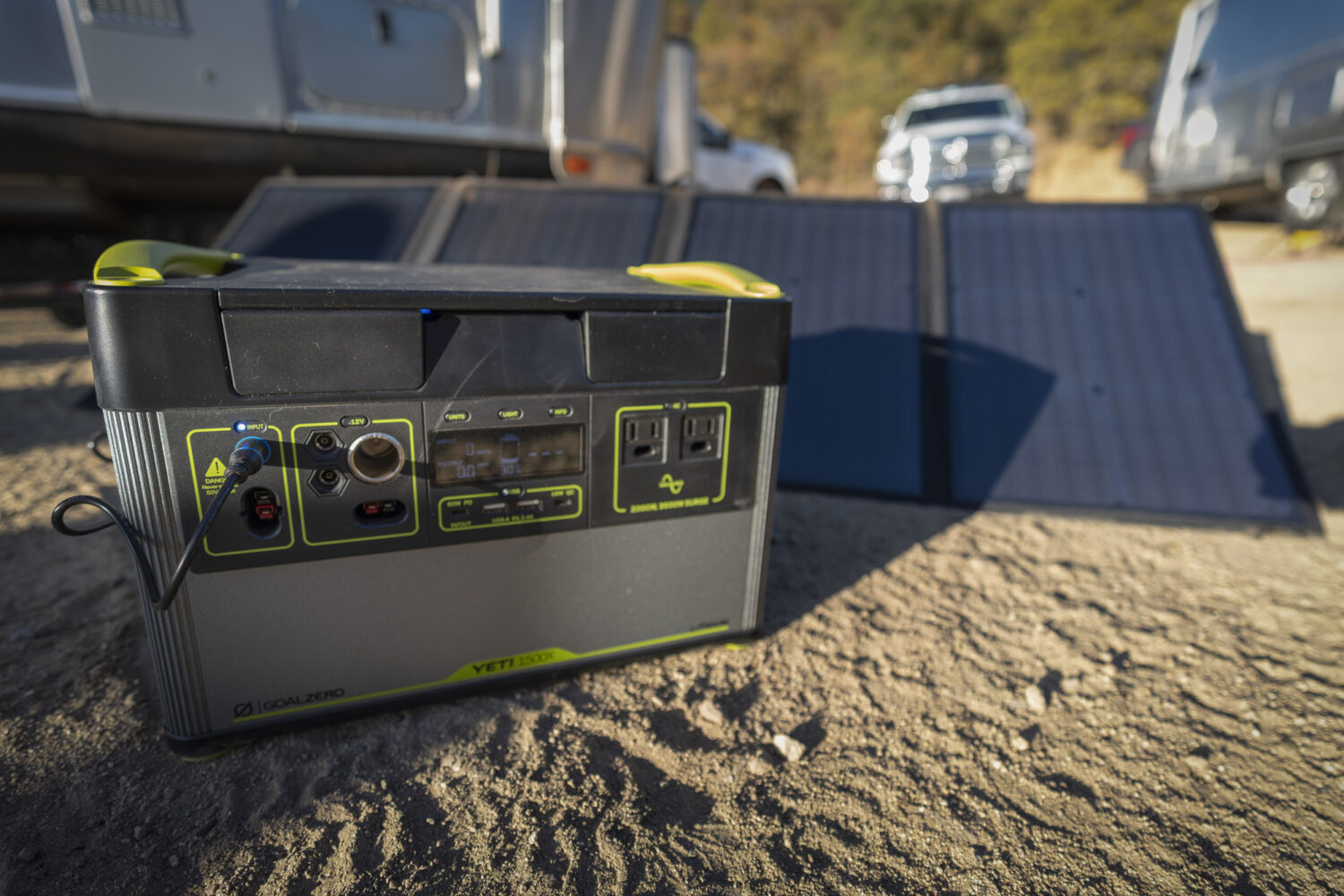
Goal Zero was founded in 2008, but before they officially became a business, they had already deployed their first product, the GoBe, to rural Africa. It was a simple off-grid power pack consisting of a battery, solar panel, and LED light. The goal of the GoBe was simple, to bring light and economic empowerment to rural communities.
As they continued growing, Goal Zero looked for opportunities to help communities in need. They deployed their off-grid power products to Haiti following the earthquake in February 2010 and to survivors of the Japanese Tōhoku earthquake and tsunami in March 2011.
The 1500X is the newest evolution in the company’s Yeti line of products. The 1500x features a lithium-ion-nickel-manganese-cobalt-oxide battery that is rated at 140.4 amp-hours at 10.8 volts.
As one of the heavier products in our test at 46 pounds, my initial assumption was that the 1500X would have the best power density, which was confirmed in testing. Starting with its battery at 100 percent, the Yeti ran a 1,000-watt AC halogen light for 1 hour and 5 minutes before reaching our benchmark of 80-percent battery discharge.
While the Yeti performed best in the field in regard to power density, it was the slowest to recharge, taking 10 hours and 17 minutes to reach 100 percent using the included AC wall charger.
Although the 1500X is the most expensive product in our test, it offered the highest quality user experience. Its illuminated LCD display provides ample practical information, including battery voltage with a visual display of remaining charge, charging input (watts), and output in either watts, amps, or watt-hours. Finally, the Yeti calculates and displays the remaining “hours to empty” in real-time as you plug devices into the DC or AC outlets.
The Yeti has a significant and useful variety of input and output options, including one powerpole and two DC barrel inputs; two 12-volt powerpole, two DC barrel, one 12-volt automotive, two 110-volt AC outlets; two USB-C and two USB-A ports. The AC outlets are powered by a 2,000-watt pure sine wave inverter with a surge rating of 3,500 watts. All of the outlets/ports are accessible from the front of the unit.
Rounding out the Yeti are a handful of helpful features, some of which are not found on any other power stations in our test. For instance, WiFi and Bluetooth are built in to allow you to pair your smartphone for remote monitoring and operation from anywhere in the world (via the WiFi connection). There is also a compartment underneath the top lid, a convenient place to store the chargers when they are not in use.
Additional charging modules can be purchased and integrated into the Yeti, allowing users to connect additional external batteries, increasing the storage capacity of the entire system.
PROS: Feature-rich, high power density, easily integrates into hardwired systems, expandable
CONS: Cost, slowest recharge with standard AC adaptor
$2,000 | GOALZERO.COM
RENOGY | LYCAN POWERBOX
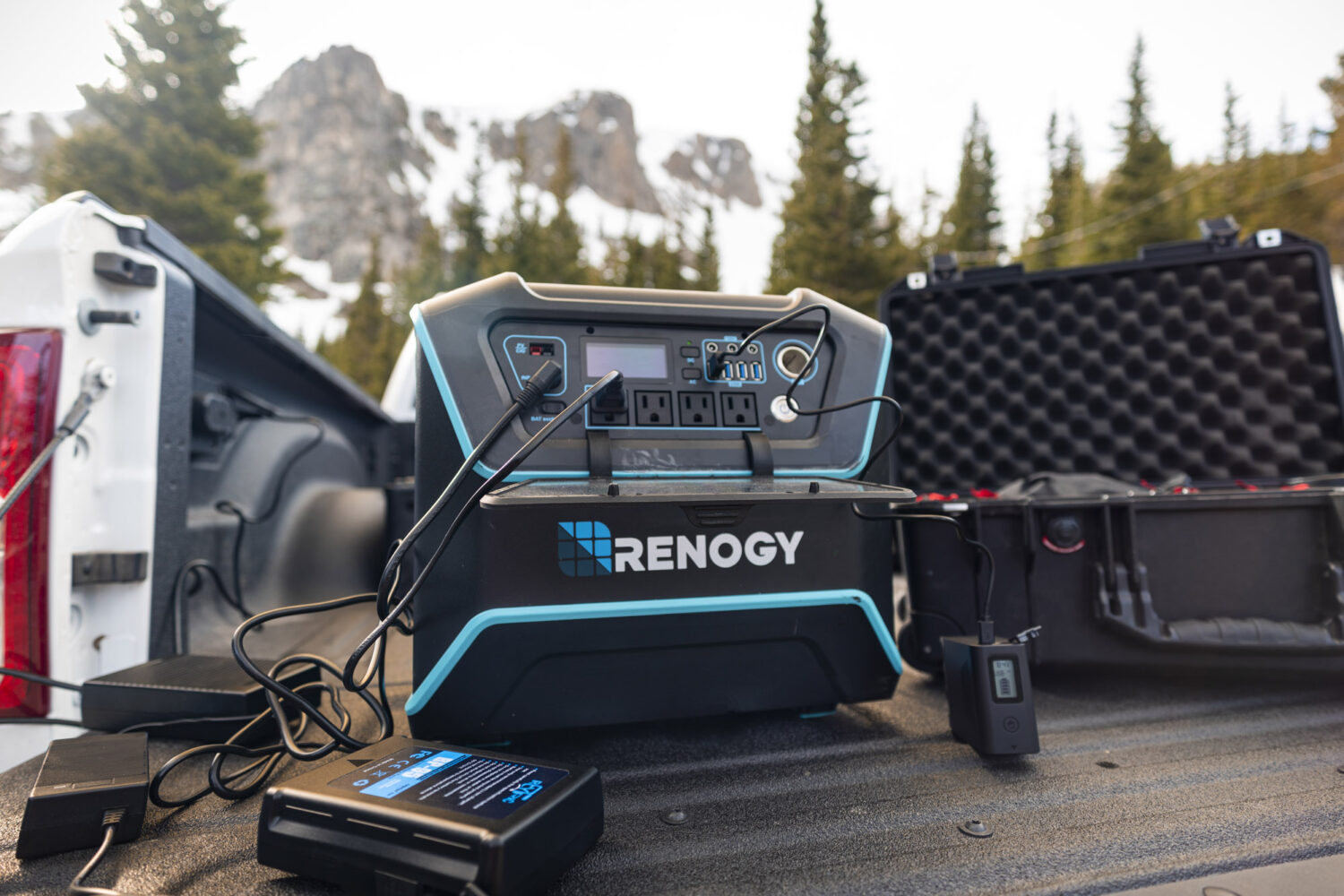
Renogy got its start as a student project at Louisiana State University and has grown into a widely known renewable energy company, selling both mobile, residential, and commercial solar products.
The Powerbox is an all-in-one off-grid power system that utilizes a lithium-iron-phosphate battery. It was the heaviest product in the test, weighing in at 54.5 pounds. But it was also the only portable system that I tested with integrated wheels and a telescoping handle. While these features make it much easier to move the Powerbox from point A to point B, the wheels are hard plastic and operate best on even hard surfaces (read: challenging to wheel around on dirt, gravel, and sand).
The Powerbox is rated at 24 amp-hours at 44.8 volts, and in our AC output test, it powered a 1,000-watt halogen shop light for 51 minutes before reaching our benchmark of 80-percent battery discharge. In the recharge test, the Powerbox took 9 hours and 58 minutes to reach 100-percent capacity using the included AC wall charger.
When charging, the Lycan’s LCD screen displays both input voltage and amperage. However, aside from showing which output circuits are active (AC or DC), the Powerbox does not display how much power is actively being used. It only displays the remaining battery capacity as a percentage (no estimate of time).
The Lycan has one DC powerpole and one barrel input (for the included AC charger). It has three 12-volt barrel, one 12-volt auxiliary, and four AC outlets that are powered by a 1,200-watt pure sine wave inverter, along with four USB-A ports. The Lycan offers the unique ability to charge aftermarket external lead-acid and lithium batteries via dedicated powerpole and XT90 interfaces (found on the back of the unit next to two 30-amp user-replaceable fuses).
On top of the Lycan, you’ll find a small compartment underneath a hinged lid with just enough room to store the included AC charging brick. The underside of the lid has an integrated LED floodlight which is helpful for illuminating the immediate area. An integrated plastic cover with a gasket protects the outlets on the front of the Lycan, a particularly handy feature if you find yourself traveling in dusty or wet environments (but it must be removed to access the outlets).
Overall, the Powerbox is a versatile off-grid power solution. Although it’s a bit bigger than everything else I tested, it is priced competitively.
PROS: Wheels for easy moving, can charge Li-ion and Pb batteries
CONS: Largest footprint
$1,800 | RENOGY.COM
ECOFLOW | DELTA

EcoFlow was founded in 2017 by a group of entrepreneurs who had previously worked at one of the leading drone companies, where they focused on refining battery technology to deliver long-lasting power in a lightweight package. Taking this base of knowledge and using it to develop off-grid power products was a logical path.
The first EcoFlow product, the River off-grid power station, was launched in June 2017 and immediately received praise. That success helped EcoFlow down the road when they introduced the Delta via Kickstarter and successfully raised $5 million for the project. Now in 2021, EcoFlow offers a whole line of off-grid power solutions ranging from small USB-only, pocket-sized power banks to their biggest product, the Delta.
*Editor’s note: since this article was published, EcoFlow has released two new products with higher power capacity, the Delta Pro and the Delta Max.
I’ve known about EcoFlow for a few years, but this was the first of their products that I’ve had the opportunity to test. The Delta is powered by a lithium-ion battery rated for 25 amp-hours at 50.4 volts. In our AC load test, it powered our 1,000-watt halogen light for 50 minutes before hitting our benchmark of 80-percent battery discharge. In the recharging test, the Delta blew me away, recharging from 20 to 100 percent in only 1 hour and 4 minutes.
I think it bears mentioning that the reason the Delta is able to recharge so quickly is due to its integrated AC charging port that pulled in up to 1,100 watts AC. This is excellent if you are charging the Delta from an AC power source, but if you are charging from a DC or solar source, the Delta maxes out at 65 volts and 10 amps, resulting in slower charging times of 4 to 8 hours depending on the voltage input.
The Delta has an input for AC voltage using their supplied AC power cord along with a male XT90 outlet that accepts a female XT90 solar or DC power input. For outputs, the Delta has six AC outlets (the most out of all units tested) which can deliver a maximum of 1,800 watts of continuous AC power via a pure sine wave inverter. It also has one 12-volt automotive outlet and four USB-A and two USB-C ports. The Delta’s LCD screen, which lights up for easy viewing, shows remaining battery use time, battery charge percentage, and real-time input/output in watts. When charging, it displays the estimated time remaining until full.
I really like the form factor of the Delta; it is narrow and relatively lightweight at 30 pounds. It also has a nice flat top which is a great place to put items that are charging, such as phones or a laptop. I also applaud the EcoFlow team for integrating the AC charging apparatus. It’s nice only to have to keep track of a relatively small AC power cord with a c13 female device end (easy/cheap to replace and not proprietary). My only major gripe is that the output power ports are split between the front and back of the Delta, with USB ports on the front and the AC and the auxiliary DC ones on the back.
PROS: Fastest charging with AC power, price
CONS: Doesn’t easily integrate into hardwired systems
$1,399 | ECOFLOW.COM
JACKERY | EXPLORER 1000

Jackery was founded by a former Apple battery engineer in Silicon Valley back in 2012. Since then, they’ve become quite popular in the #vanlife and digital nomad circles. But their products are useful for anyone who spends time off the power grid.
They are a fast-growing company, and there are already some bigger, more powerful units that have joined their lineup since I originally got my hands on the Explorer 1000 last year. While the 1000 was previously their largest product in terms of output and power storage, they now offer a larger Explorer 2000 with twice the power storage that can produce over 2,000 watts of continuous-use AC power. The Explorer 2000 also has an integrated AC charger (like the EcoFlow Delta), and Jackery claims a 0- to 80-percent charge in as little as two hours.
Getting back to the product at hand, the Explorer 1000 is powered by a lithium-ion-nickel-manganese-cobalt-oxide battery that is rated at 46 amp-hours at 21.6 volts. In our AC load test, the Explorer 1000 ran our 1,000-watt halogen light for 43 minutes before reaching 80-percent battery discharge. In our recharging test, the Explorer 1000 took 5 hours and 36 minutes to go from 20 to 100 percent.
The Explorer features a powerpole input for connecting solar panels and can accept a maximum input of 30 volts or 136 watts. It also has a DC barrel input for use with the included AC wall charger. For power output, it has an auxiliary 12-volt automotive and three 110-volt AC outlets which are powered by an integrated 1,000-watt pure sine wave inverter; there are also two USB-C and two USB-A ports. Although its power density is a little bit less than our other products, the Jackery weighs in as one of the lightest in the test at 22 pounds. It has a central handle that makes it reasonably easy to carry around, but this means that you cannot easily rest devices on top of the unit while they are charging.
The Explorer features a built-in light on one end, which, although small, can illuminate the immediate area in front of you (think walking from your vehicle to the tent or wherever else you might want to have a power source). The light-up LCD screen displays input and output wattage as well as battery percentage. Unfortunately, this is the extent of the information that is displayed.
The Jackery is a capable unit for its size and is worth considering if you are looking to add off-grid power on a budget.
PROS: Relatively lightweight, inexpensive
CONS: Lower power density, doesn’t easily integrate into hardwired systems
$999 | JACKERY.COM
DOMETIC | PLB40
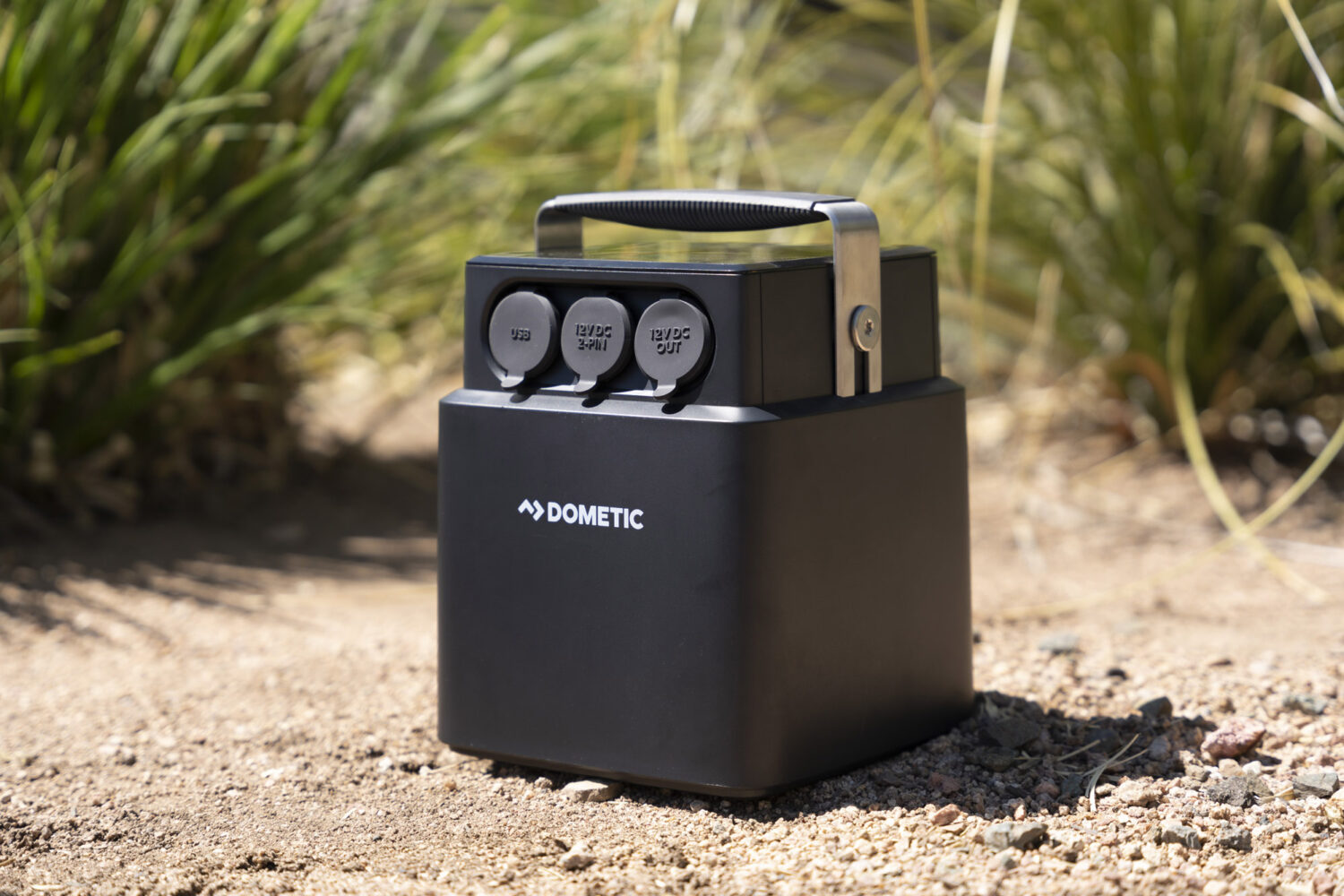
Not everyone who is looking for off-grid power needs a massive battery or high AC output. When I think about my own off-grid experiences, I generally only need to charge a handful of USB devices or run a 12-volt refrigerator. And this is where the Dometic PLB shines. It’s a tiny off-grid power source that is specifically designed for providing 12-volt power.
At 17 pounds, the PLB40 is the lightest and most compact of the products tested. It’s powered by a lithium-iron-phosphate battery that is rated for 40 amp-hours at 12.8 volts. The secret behind its weight savings and tiny footprint? It all comes down to what is inside its housing.
The PLB40 does not have an integrated AC inverter. This fact, combined with its battery which is roughly half the size of the others in our test, results in a tiny form factor. For these reasons, the PLB is also a little tricky to compare to the other products in our test.
Total power output from the 12-volt automotive outlet is higher than average at 15 amps. But despite its ability to output enough power to run the 1,000-watt halogen light with an external AC inverter, I opted not to perform this test with the PLB. My reasoning was that most users who need the ability to use high-voltage AC appliances regularly would likely choose a different product (and that would be my recommendation).
I did, however, put the PLB through our standard recharging test using the included 10-amp AC charger. Starting with the battery capacity at 20 percent and charging to 100 percent took 5 hours exactly. The PLB40 can also be charged via solar panels as long as solar input does not exceed 8 amps or 25 volts.
Overall, the user experience with the PLB40 was positive; DC refrigerators were powered with ease, and given its diminutive size, it has superb power density. The illuminated LCD screen is easy to read, although I found myself wanting slightly deeper insights into power usage and estimated time remaining. The PLB has one 12-volt automotive, one 12-volt, 2-pin (ideal for Dometic refrigerator owners), and two USB-A ports. The extendable metal handle on top of the device is comfortable when you need to carry the PLB from your car to camp or wherever else you might want to use it.
One thing I didn’t love about this product was the capacitive button for turning the device on and off. Without any tactile feedback, sometimes I thought it wasn’t working properly, when in fact, I didn’t have my finger centered on the button. Overall, its size was a huge convenience when space was limited in smaller vehicles.
PROS: Tiny footprint, lightweight
CONS: Capacitive button design, high cost per amp-hour, no built-in AC inverter
$850 | DOMETIC.COM
ADDITIONAL CONSIDERATIONS
While I would have liked to have tested every battery box on the market, the reality is that I was unable to procure some products from manufacturers, and some are still in development. Here are some additional products that you may want to consider.
NATIONAL LUNA | 12-VOLT AUXILIARY BATTERY BOX
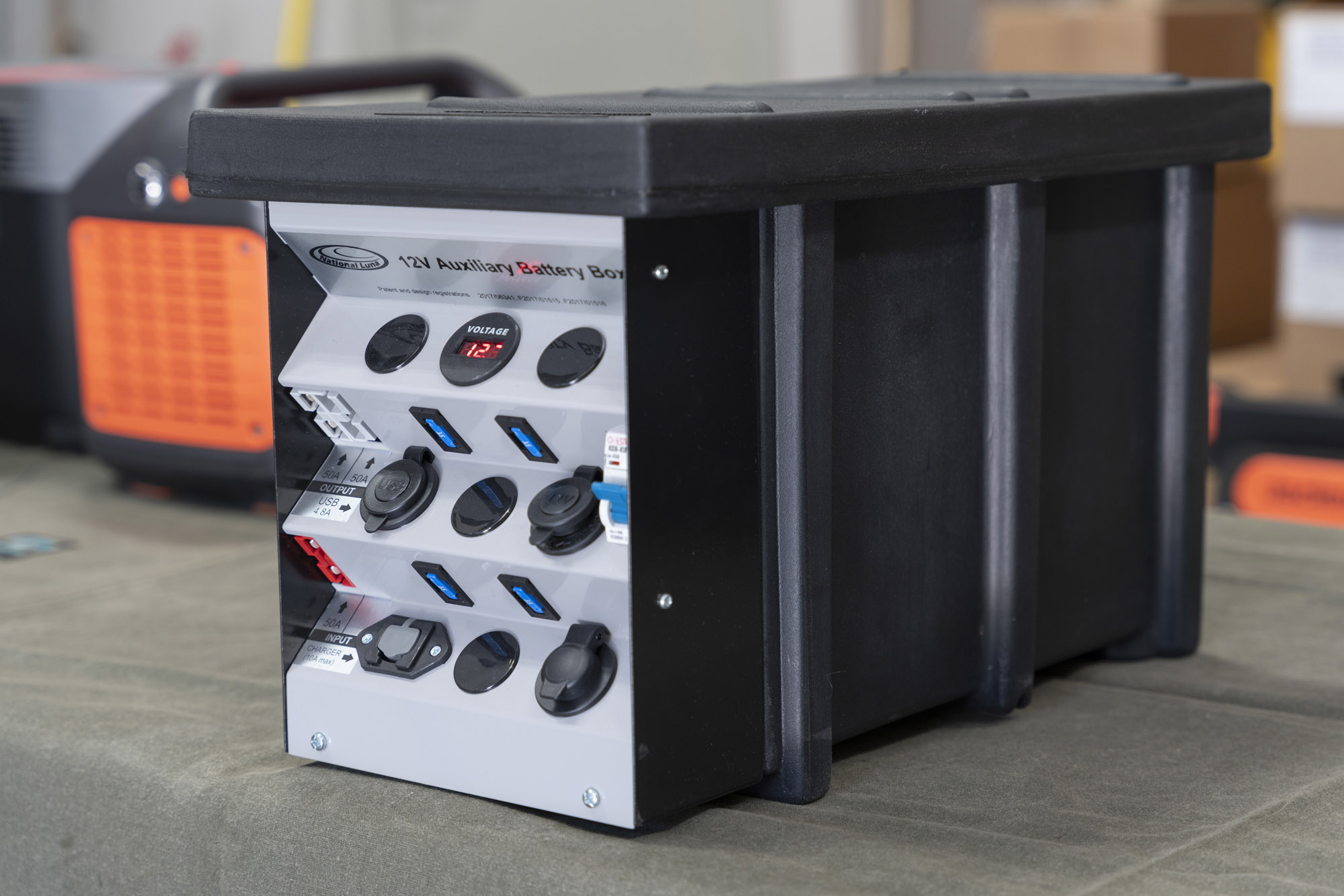

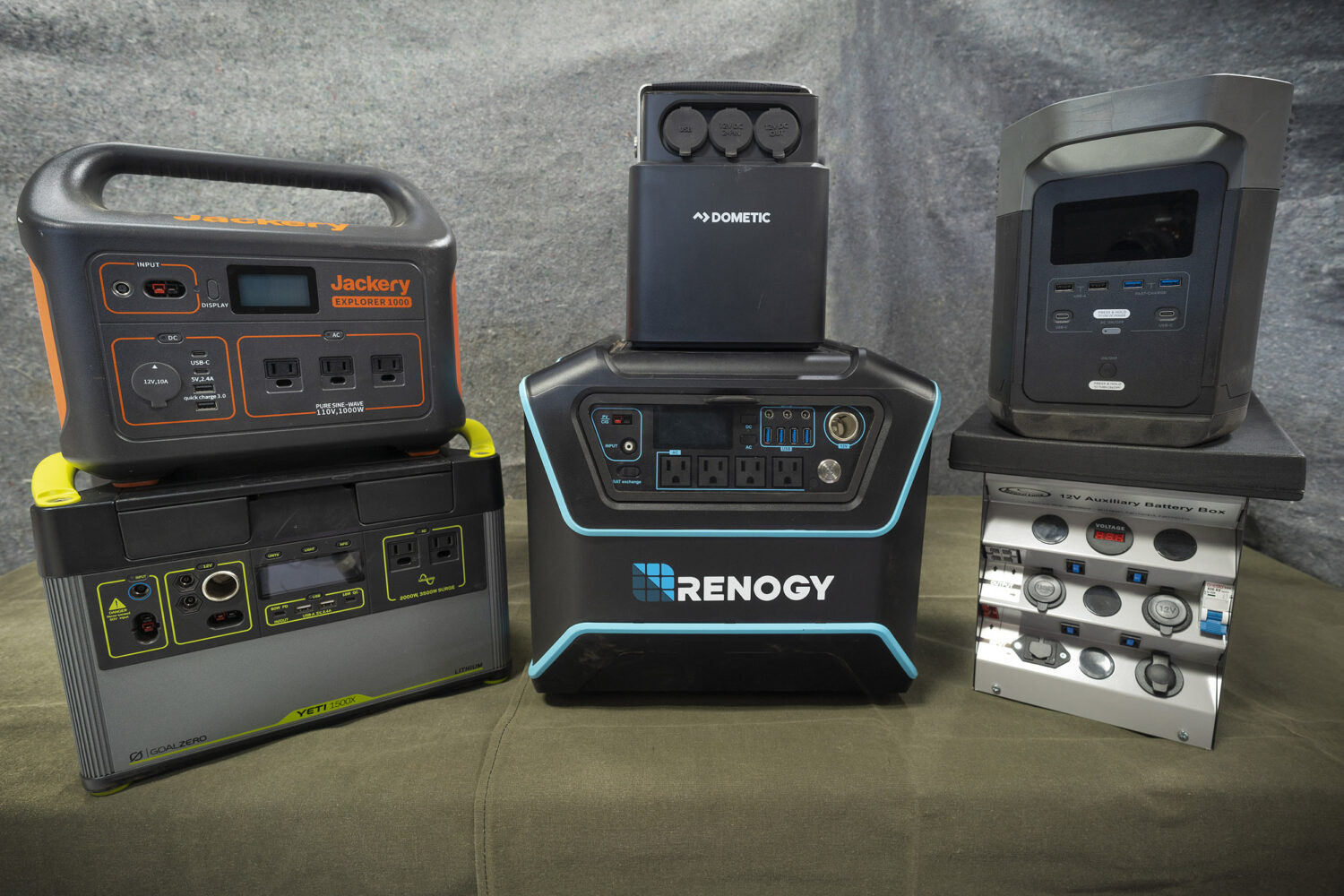
The National Luna auxiliary battery box allows you to use any 12-volt vehicle battery (although a deep-cycle AGM would be best) to create an off-grid power source. The battery is secured inside the box using the included hardware and hooks up to positive and negative cables—very straightforward. You get two USB-A ports, one 12-volt automotive outlet, and one 12-volt Hella outlet, with four more prewired 12-volt outlets which you can adapt to your needs. Because this device doesn’t provide AC power, and because the internal battery is supplied by the user, it didn’t feel appropriate to compare it to the items in our test. The National Luna is pictured above with the other battery boxes on the lower right-hand side.
$345 | NATIONALLUNA.COM
INERGY | FLEX 1500

The Flex has a unique, modular, stackable design. The inverter and charge controller are housed in one unit which sits on top of a 1,069-watt-hour lithium-ion battery module. This allows you to easily increase the storage capacity of your power station by stacking multiple batteries below the controller unit, or you can also swap out depleted batteries for fresh ones. The Flex features six AC outlets with a maximum 1,500 watts of continuous AC power output via a pure sine wave inverter. It also has regulated DC power and can handle up to 90 volts of solar input.
$1,500 | INERGYTEK.COM
OMNI | OFF-GRID

The Off-grid just completed a successful Kickstarter campaign where it raised over $400,000 for development. It’s a 2,000-watt-hour off-grid power station with a 2,000-watt continuous output pure sine wave inverter with a surge rating of 4,800 watts AC. The Omni can be charged via AC power or up to 600 watts of solar input at 60 amps. It can also be connected to additional battery modules for increased power storage. Perhaps the most unique feature of this device is the Connect Module incorporated into the power station to provide wireless communication up to two miles (in walkie-talkie mode) or up to five miles in text-only mode.
$2,099 | INDIEGOGO.COM, OMNICHARGE.CO
SUNBOX LABS | BATTERY
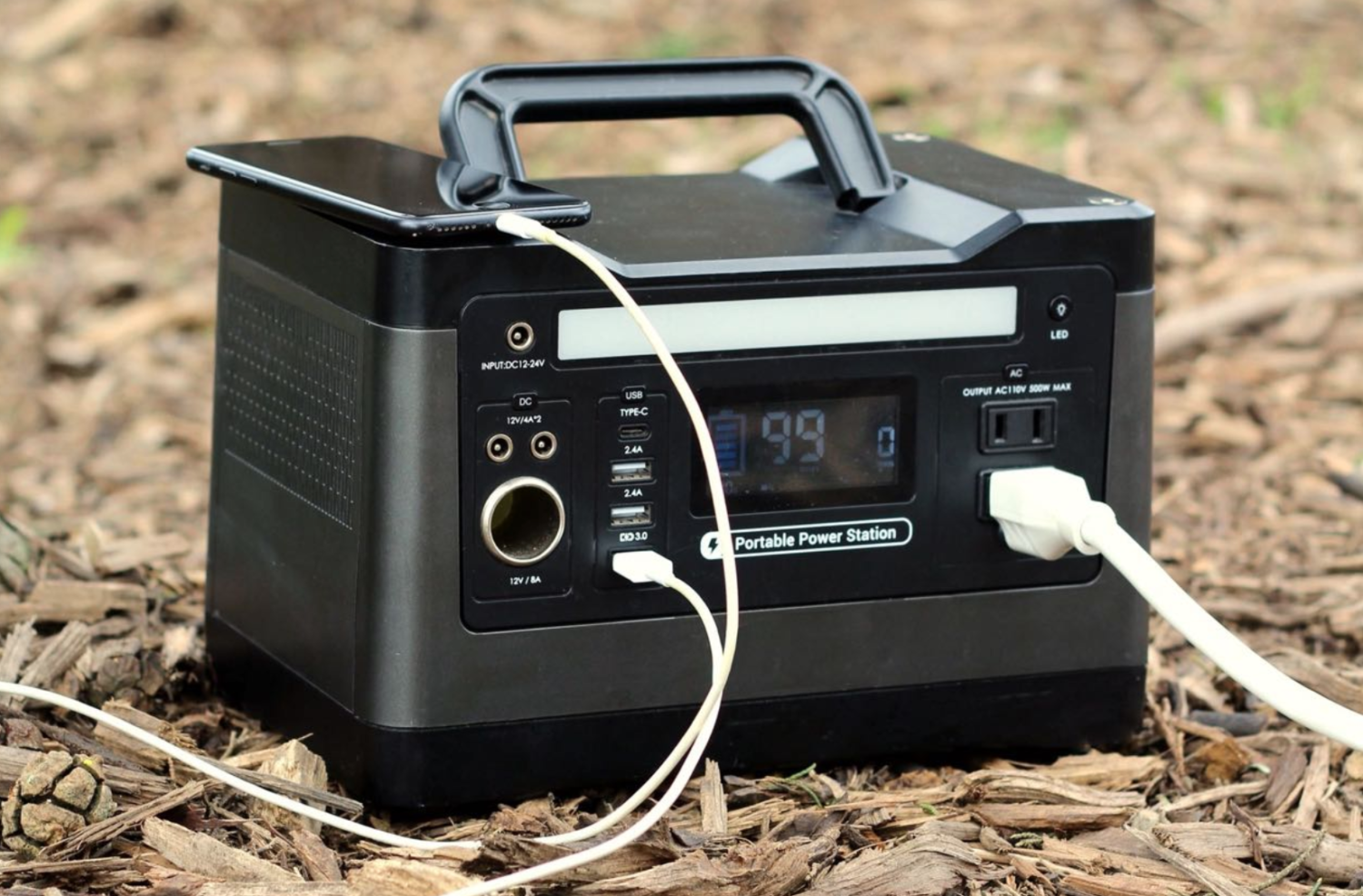
The Sunbox is a relatively compact off-grid power station rated at 540 watt-hours. Its integrated pure sine wave inverter powers two AC outlets and offers continuous 500-watt AC output with a 1,000-watt surge rating. It can be charged in as little as three hours with the included AC charger and accommodate up to 200 watts of solar input for off-grid charging. While the Sunbox has a reduced footprint compared to some of the other products tested, it is one of the more affordable solutions if you are looking to power smaller devices.
$449 | SUNBOXLABS.COM
BLUETTI | EB240
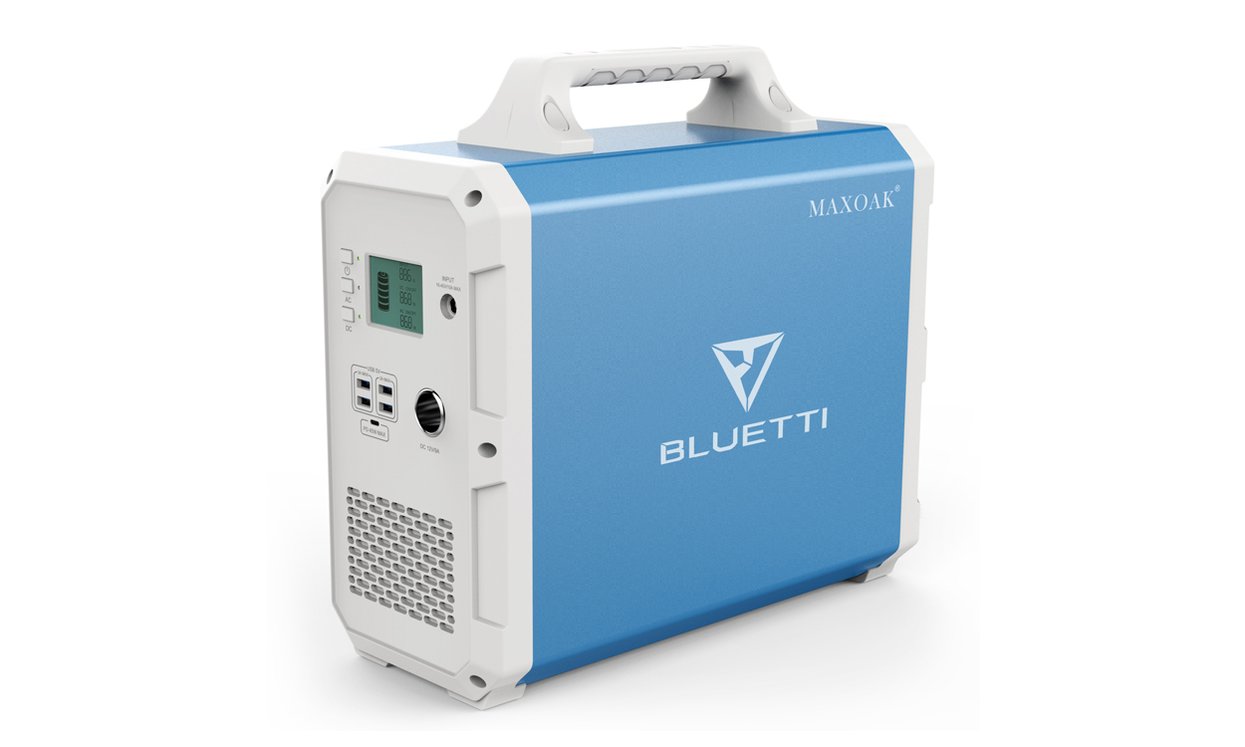
The Bluetti EB240 is one of the largest-capacity off-grid power solutions I’ve come across, with 2,400 watt-hours of LG lithium batteries. It has two AC outlets powered by a 1,000-watt continuous output pure sine wave inverter with a 1,200-watt surge rating. It also has four USB-A ports, one USB-C port, and one 12-volt automotive outlet. The built-in MPPT charge controller can manage up to 500 watts of solar input at 10 amps. Because of its larger capacity, charge times are approximately 12 hours via the included AC wall charger, or 15 hours using 200 watts of solar panels (in full sun).
$1,900 | BLUETTI.COM
CONCLUSIONS
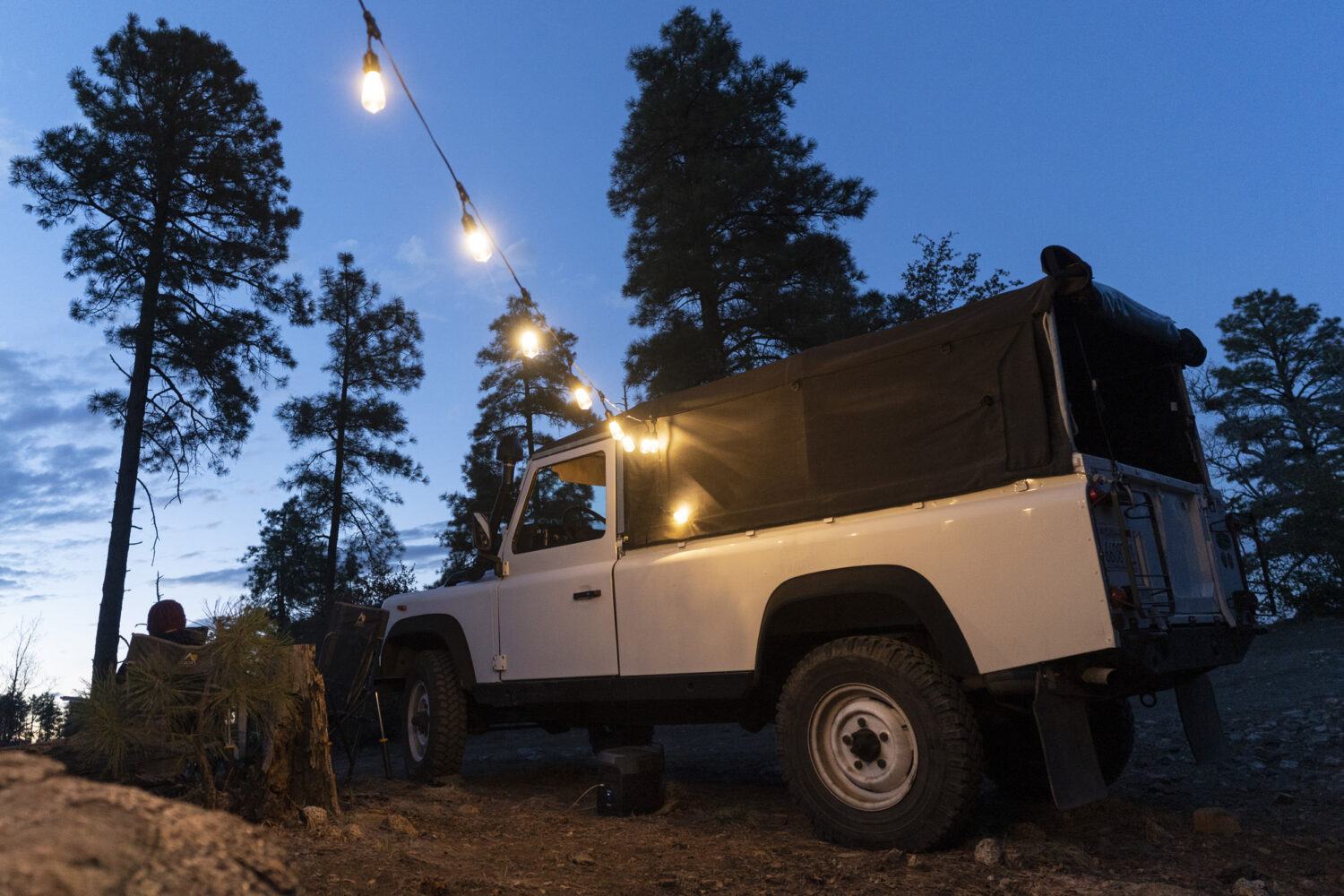
This initial test of off-grid power solutions provided useful data but also raised additional questions which were outside the scope of my ability to test. For instance, validating some of the information provided by the device screens would require readings to be taken from inside the product housings, something I wouldn’t attempt without the assistance of an electrical engineer. I would also perform additional depletion and charging tests using a standardized and regulated DC power source to get a more valid side-by-side comparison of the units.
But despite these realizations about my testing procedures, I am satisfied with the data that I was able to collect in this process. And ultimately, my first-hand experience using these power stations generated some valuable insights.
EDITOR’S CHOICE: GOAL ZERO YETI 1500X
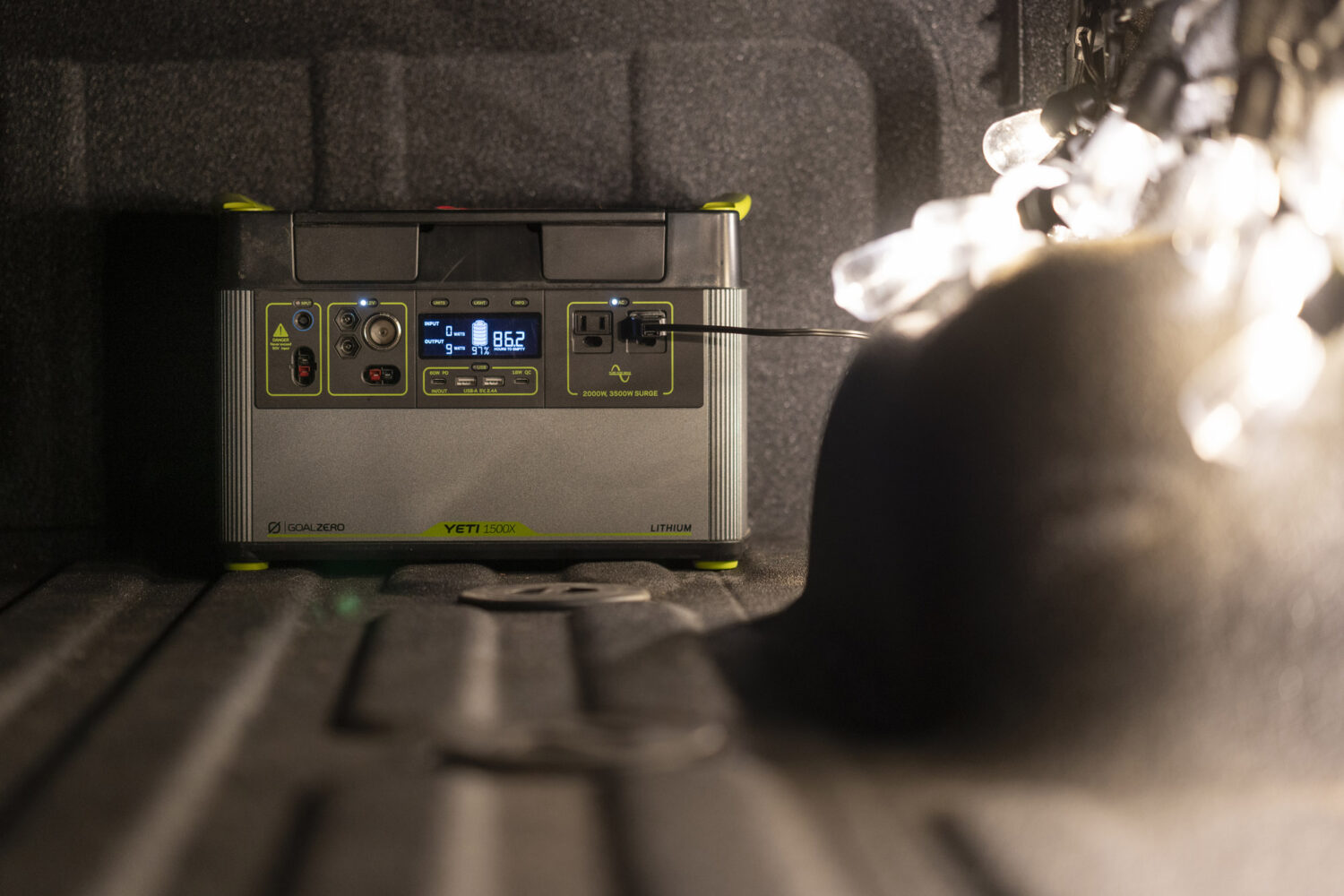
Because of its large variety of inputs and outputs, all of which are accessible from the front of the unit, the Yeti is the easiest and most likely solution for integration with an existing hardwired DC electrical system. This can be accomplished through a single 30-amp powerpole connection.
In addition to this convenience, the Yeti has the most powerful AC inverter in the group and the best power density. It also has advanced features such as WiFi and Bluetooth, giving users the ability to adjust charging and use profiles and update product firmware, which could lead to increased efficiency via updates from Goal Zero. Finally, the Yeti has a wide variety of accessories that can enhance its functionality, including a 600-watt AC charger which will fill its battery in as little as 3 hours.
VALUE AWARD: ECOFLOW DELTA

The EcoFlow Delta has the second-largest inverter, with 1,800 watts AC continuous output. It also has a large variety of outlets. Using the integrated AC charging interface, the Delta absolutely crushed all of the other products in our test, recharging from 20 to 100 percent in just 1 hour and 4 minutes.
Like the Yeti, the Delta also offers valuable real-time data on its LCD display, with input, output, battery percentage, and estimated time until empty. Keep in mind that the Delta lacks a high-amperage DC output for integration into a hardwired DC electrical system, and its AC outlets are located on the back of the unit. But despite these minor issues, the reasonable price is difficult to overlook.
Our No Compromise Clause: We carefully screen all contributors to make sure they are independent and impartial. We never have and never will accept advertorial, and we do not allow advertising to influence our product or destination reviews.


